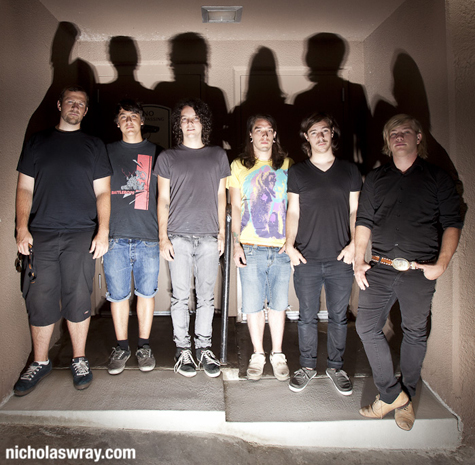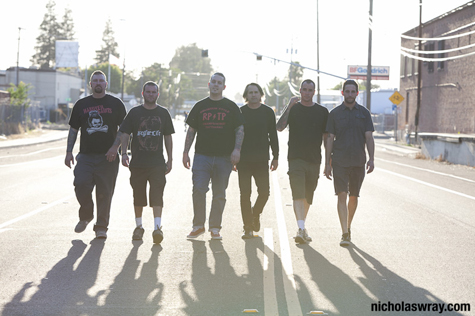Sacramento Restaurant Receives National Recognition
The Kitchen Restaurant – 2225 Hurley Way, Sacramento
Words by Adam Saake – Photos by Nicholas Wray
Twenty-five years ago, the James Beard Foundation began honoring those in the food and beverage world who were working at a level of excellence. Beard was a highly regarded chef, author and personality whose career spanned over five decades. His passion for cuisine of all different cultures and styles is the spirit and backbone of the foundation’s scholarship program and awards process. Called the “Oscars of the food world” by Time Magazine, The James Beard Foundation Awards recognize cookbook writers and food journalists, TV personalities and photographers, chefs and restaurateurs. Some of the awards celebrate the new and most recent; but other more prestigious awards, like the Outstanding Restaurant Award, require years of consistent quality and service before even being considered. The James Beard website describes the Outstanding Restaurant award as, “A restaurant in the United States that serves as a national standard-bearer for consistent quality and excellence in food, atmosphere and service. Candidates must have been in operation for at least 10 or more consecutive years.” So when Sacramento’s own The Kitchen Restaurant was nominated as one of 20 of the nation’s most outstanding restaurants, the news brought surprise and shock to the Selland Family Restaurant Group.
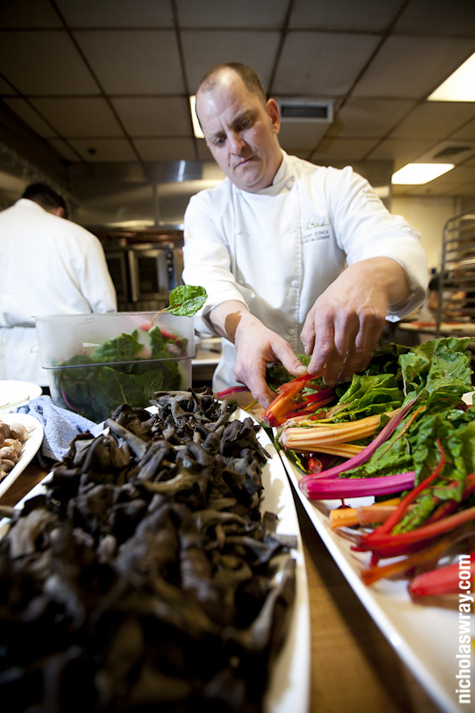
“We were blown away by the whole thing,” says The Kitchen owner and Executive Chef Randall Selland. “If you look at the list of restaurants, it’s just phenomenal.”
The nomination alone is sort of like an award itself, considering the weight that a JBF Award carries. It came unsolicited as well, which means that JBF found them through the hundreds of restaurants all across the nation to be considered.
“We didn’t lobby for it, we didn’t know. It was more of a surprise to us than anything else,” says Selland. “It’s not the award part of it, it’s the recognition. I’m excited to no end that we got this nomination.”
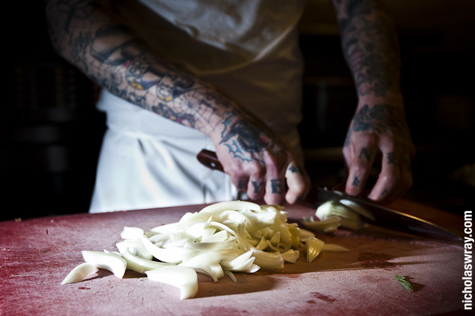
But it really is no surprise that The Kitchen be considered for this prestigious award. The kind of experience offered to guests during the one-seat-per-night dinners is truly of the highest caliber and is sought out and enjoyed by diners searching for the best. It is a spectacle; a show with a cast of characters who throughout the night take the stage to present their course like a ringmaster describing the perils of the lion tamer and trapeze artists. Watch as it all happens right before your eyes! The ringmaster is most certainly Chef de Cuisine, Noah Zonca. Zonca is a showman, a personality and most importantly a talent. When he talks to the crowd, he holds them in his hand, and when he personally addresses you, you feel important in the moment. He prepares visually dazzling courses right before your eyes, often bringing members of the crowd up to hold the pan as it flames up into the hood. He laces the night with humor, making guests feel warm and comfortable at the same time he commands his young staff, ensuring that each course is properly executed.
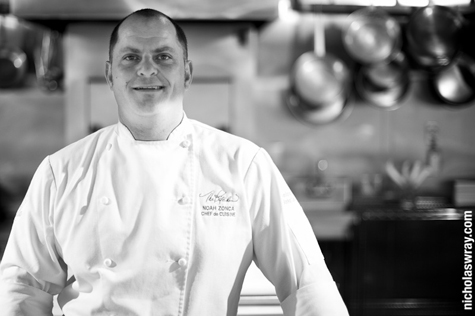
At the beginning of each dinner, doors open at 6:30 p.m. as a brand new group of elated guests spill into the main dining area. They’re immediately greeted by the impeccable Kitchen manager Eric Philbin, jackets carefully removed, purse hooks pointed out and seats shown. From the second they arrive, they’re pampered in a true professional fashion. The busy dining room fills with chatter, quiet laughter and the encouraged nosiness. One of the chefs stands main stage, preparing a sushi roll filled with yellow tail. “Come on up if you like,” he says to a group of bystanders. They step up into the kitchen and approach as he begins explaining the ingredients, their provenance and flavors. This is a show, but it’s transparent with no curtains. What you see is where it all happens and that is why The Kitchen has become a premier dining experience in not only Sacramento but in the country. It’s all about making the guest feel comfortable, giving them what they’ll enjoy and showing them a good time. And they do it well. Don’t like the first course? They’ll make you something else. Feeling like dessert first? Coming right up.
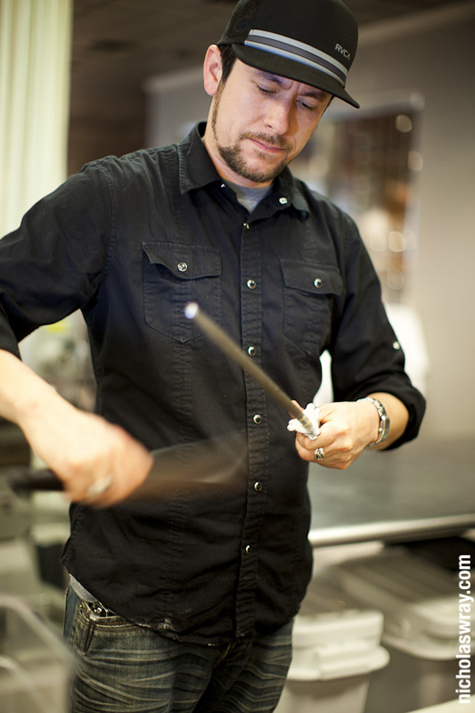
The main attraction is the food, of course, and Selland, Chef Nancy Zimmer and Zonca construct plates and flavors that are inspiring to look at and enjoy. With the colors and combinations of ingredients, conjuring styles of French technique woven with Thai and Japanese influences, their New American cuisine is the finest of dining in the most accessible way. This is how Selland prefers his plates to be.
“I get people to come in, and they feel a bit uncomfortable because they read the menu and they’re more meat and potatoes. Then they find out we’ll give them whatever they want and also, the menu reads a certain way but then when they get the food, the food’s always approachable,” says Selland.
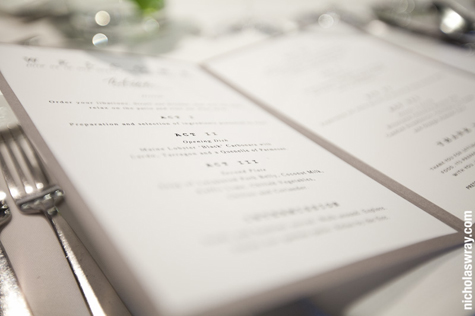
The opening dish for their March menu, called Act II, which followed Zonca’s in-depth description of what guests would be enjoying and how it would be prepared, was a show stopper right from the get-go. A Maine lobster “black” carbonara with crispy lardo, tarragon and a luscious quenelle of Parmesan–a dish whose mere remembrance of makes my mouth salivate. Each course that followed had some peppering of distant cuisines, something that Selland and Zimmer pride themselves on from their past travels to countries like Mexico and Turkey where they found big inspiration in small corners.
“We get more inspiration from the taco cart or the hero sandwich in Turkey, or the little mom and pop place somewhere,” says Selland.
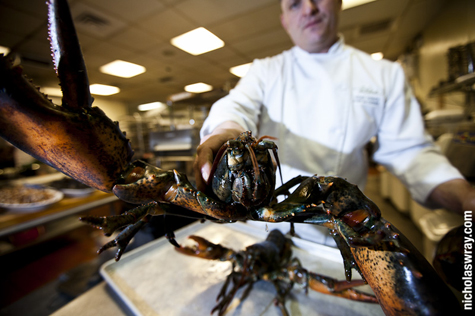
Act III, the second plate, certainly tasted of Thailand with a soup of lacquered pork belly, coconut milk, Kaffir lime, chilled vegetables, chilies and coriander. It reminded me of a light, more citrus-y curry broth with the coconut milk and Kaffir lime really shining through and playing nicely off the fatty pork belly. What followed was Intermission, hardly cookies and coffee, but an elaborate array of sashimi, sushi rolls, freshly ground wasabi root and other light appetizers. Guests meandered around the restaurant, snacking with their wooden chop sticks and poking their heads around the wine cellar and back of the kitchen.
Selland describes the early years of The Kitchen: the restaurant was based off of a concept and it was his and his wife’s side gig. He put every bit of free time into it, cooking at The Kitchen on his only day off during the week.
“When we started The Kitchen, it was a once a month deal, basically trying to drag people off the street, beg friends to go,” says Selland candidly.
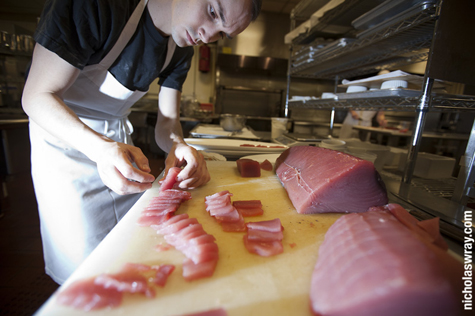
It slowly started to come to fruition and what started out as once month turned into once a week, then three times a week. The beginnings were simple; $35 a head and guests would bring their own wine. The original concept was a lot like how it is today, minus the price tag, which has gone up considerably over the years.
“The same thing we do now; it’s social interaction. You get to interact with the people cooking your food,” says Selland.
What is most endearing about The Kitchen is its uncompromising commitment to excellent service. Selland and Zimmer wanted to service the guests and make food for them that they would enjoy and walk away feeling good about. Not scratching their heads wondering what exactly they just ate or feeling like the reason they didn’t like their meal was because there was something wrong with them.
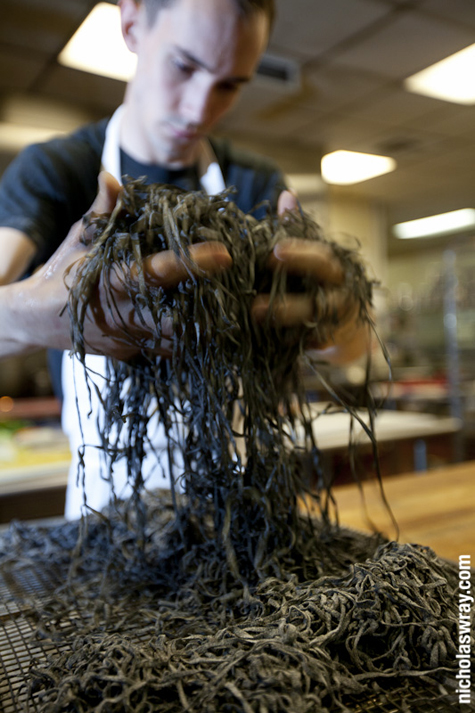
“We don’t care that you didn’t like it. I’ve been to restaurants where I’ve had the waiter say, ‘Well I’m sorry sir, but that’s how the chef cooks it.’ I don’t care about that,” says Selland with passion in his voice. “Here if I cook it perfect for someone and they don’t like it, my question to them is not, it’s supposed to be like this, it’s a matter of what did you not like about it and let me prepare something different for you that hopefully you will like.” As the last course approached–a grilled natural veal, perfectly pink that Zonca sliced himself–two, four, six cooks appeared one by one behind the line, mixing and changing places with plates and duties, Zonca calling out assignments of where to be, what time and dietary restraints. Each cook was listening, interpreting, reacting to each instruction. It’s a rare opportunity to see all the working parts of a kitchen all happening at once to bring you the plate that will sit before you. The drama that unfolds on a nightly basis at The Kitchen, a Sacramento destination restaurant that sits quietly behind an ivy-covered retaining wall, hidden, is what landed them a JBF Awards nomination.
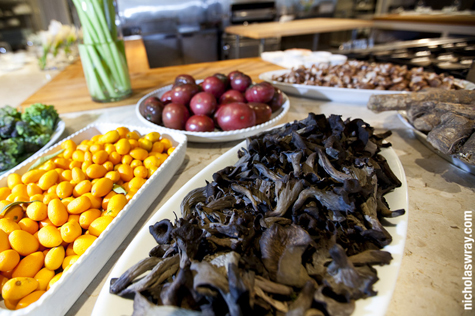
The finalists were narrowed down from 20 to five this past Monday, March 19, 2012 and The Kitchen did not make the cut. But there should be little disappointment, because the JBF nomination has only sparked more excitement for fans of The Kitchen and will certainly generate more excitement for those yet to experience an evening with Zonca and crew.

Sizzling Sirens teach Sacramento how to shake it
Silky bustiers, black feather boas, strings of pearls and a random pair of motorcycle handlebars made of PVC pipe are painted silver and lay on the floor. A gold vintage sofa rests near two racks lined with handmade costumes, including bras stitched with imitation cash and coins. Beneath a clutter of buttons, jewelry and a tower of sewing knick-knacks appears to be a desk–a typical day at the office, if you’re a Siren. This is the headquarters of Sacramento’s only active burlesque troupe, the Sizzling Sirens, a team of 10 women ranging in ages 19 to 43 years old, each radiating with a flare that is uniquely her own.
A little vaudeville filled with theatrical satire and brought to life with provocative striptease and choreographed dance numbers defines burlesque entertainment in the simplest terms. But when Jay Siren founded the company in March 2008, she envisioned this classic genre of performance art with a couple modern alterations. Siren started teaching her first round of classes at The Press Club later that year, eventually gaining more students and at the same time finding some of the first members of Sizzling Sirens.
Since its infancy in 2008, the Sirens have built a reputation within the local music scene and around town by performing alongside bands like Agent Ribbons and Goodness Gracious Me in addition to corporate parties and events. What’s more, the gals now have a regular live show each month at Harlow’s centered around a theme, and if they ever need a live band, they turn to the veteran jazz musicians of the Harley White Jr. Orchestra for support.

“I think the greatest misconception about burlesque that we run into all the time is, ‘Where’s the pole?’” explains Jay, her off-the-shoulder black T-shirt revealing tattooed leaves spreading down her right shoulder. “For us, burlesque is burlesque-fusion. The way that we do it is a little bit different than the way that you see most burlesque presented nowadays. We take elements of everything that we love about the culture, genre and history and make it our own, mixing past and future ideas. A striptease is part of it, but in the sense of using your costume as a tool to engage your audience as though it were a prop.”
Since moving the Sizzling Sirens troupe into a gray, Victorian building on J Street last April, an idea to form a Performance Series of classes, catering to those interested in learning the art of burlesque with the opportunity to perform alongside the Sirens, was created.
Indiana Bones, Georgia Fire and Sass Herass are all present during this afternoon’s Burlesque 101 class, a one-hour introduction course into the Sirens’ world of burlesque-fusion open to the public. Each woman planted on the wooden floor of the small dance studio routinely stretches her legs and arms before claiming her space, waiting to warm up with the day’s basics.
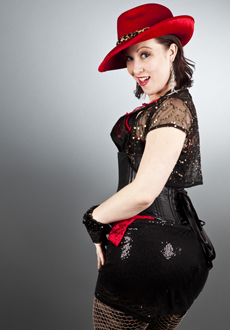
“Alright Sass, teach us some class,” says Jay clapping her hands together like an athlete ready for the next play.
Herass, wearing hot pink spanks that read, “Dance all night,” across her bum, complete with black fishnets, tall black boots and a tilted fedora, is the instructor leading the workshop this week.
Ginuwine’s “Pony” blares from the studio’s sound system and the Sirens begin loosening their hips in a circular motion to the music. Each woman follows Herass’ lead as she keeps time out loud through the steps of the warm up. Now with Etta James’ “W.O.M.A.N” changing the mood of the workshop within the small Midtown space, the four slowly bend forward to stroke the frames of their shapely legs with both hands before gracefully lifting their arms in the air like ballerinas. Using one hand, the Sirens trace the outlines of their faces, then across their chests and eventually following the curves of their bodies. Every move the same, yet differently interpreted through the personality of each Siren.
The newest member to the troupe, Fire, watches her moves in the mirror, her limbs naturally following the flow of the lesson as Bones practices pinup faces while dancing, her short red hair ornamented with a big, white bow. Jay’s once straight black locks begin to curl as the warm-up progresses, sweat glistens down her throat as she attacks each move full out. Herass, who has taught dance over five years, emanates hip-hop in each move she teaches.
“One of our biggest things that we try to reiterate is to honor your spirit and your character,” Herass says. “It’s something that I think is really important, especially with women, we are made to feel like we are supposed to fit one cookie cutter mold and burlesque is about taking what you have and accentuating it. We’re not trying to hide, or diminish anything, just being proud of who you are and what your body is and just adoring yourself. And, that’s something that I’d really like to share with everybody else.”

Through the classes Sizzling Sirens hold every week, whether its Burlesque 101, Cardio Burlesque (which is exactly how it sounds), or the Performance Series, the Sirens believe any and everyone, with the right instructor, can learn everything from how to properly shimmy to how to incorporate props into the steps, adding a personal tease to the routine.
“I would like to stress that most people come in with absolutely no theater or dance experience and they have a blast. You seriously do not have to have any dance experience to enjoy the classes. Literally, everything is all-levels. You can walk in, gain an understanding and find a challenge and enjoy it. Truly, you can enjoy this without ever having done it before,” explains Jay, fanning herself at the close of class.
And it’s true according to Fanny Coquette, a 43-year-old Siren joining the cast last August, who took her first class with Sizzling Sirens on a dare from her husband and looks forward to February’s “Good, Clean, Dirty Fun”-themed performance at Harlow’s.
“It’s just fun. It’s fun to step outside of who I am and be 100 percent who I am,” explains Coquette. “When you get older and have a family and have a regular job, there aren’t very many venues to push that line of ‘I don’t care what you think of me.’ So, it’s a great venue to relax and have fun and not worry about what other people think.”
Together Sizzling Sirens witnessed members from the first cast come and go, but have continued to grow in numbers as well as expand their reputation outside of Sacramento, performing at the DNA Lounge in San Francisco during its monthly Hubba Hubba Revue series, named one of the Top 10 Burlesque Shows to see around the world by the Travel Channel.
“I’ve never seen a group of 10 women get along and support each other creatively and emotionally,” says Jay. “Through the process of burlesquing together and learning how to create together, we’ve all become friends.”
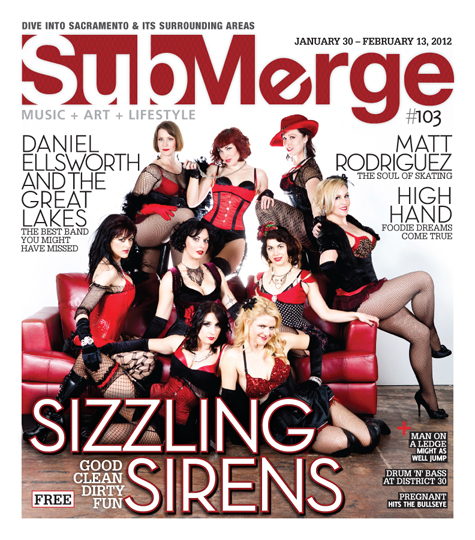
Sizzling Sirens Burlesque is located at 2419 1/ 2 J Street. Hour-long Burlesque 101 and Peel and Reveal classes are taught on Sundays (at 1 and 2:30 p.m. respectively). Cardio Burlesque is taught Tuesdays from 5:45 to 6:45 p.m. For more info on their Performance Series Workshop, go to Sizzlingsirensburlesque.com. If you prefer to watch the girls in action, check them out at Harlow’s for their “Good, Clean, Dirty Fun”-themed performance on Feb. 16 at 9 p.m. Tickets are $12 in advance and $15 at the door. 21-and-over only. You can also catch the Sirens the first Friday of every month for Fishnet Fridays at Dive Bar.
A Submerge guide to pumpkin libations
Words by Adam Saake – Photos by Nicholas Wray
Hey look! It’s fall. Oh, there it goes. Living in Sacramento, you know that fall makes a quick appearance yet there are so many ways to indulge. Having your checklist done early, your Halloween costume pre-ordered and a trip to Apple Hill in permanent marker on the calendar is a good start, but there are still a few things that fly by under the radar. Pumpkin beer is one of them and if you’re not quick to grab a six-pack off the end cap, you might miss out on some limited edition suds that can be quite delicious. What once seemed like a novelty has now become a tradition for some serious beer drinkers and the choices have multiplied. Ales, lagers and even ciders are popping up on the shelves and each offer unique takes on the flavors that this iconic orange squash has to offer.
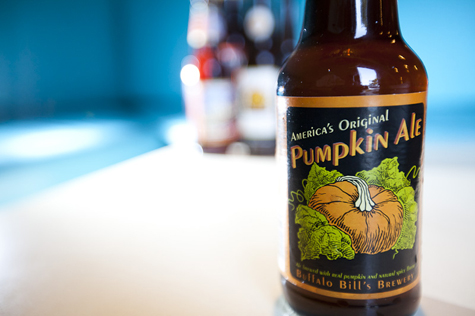
America’s Original Pumpkin Ale
Buffalo Bill’s Brewery, Hayward, Calif.
Buffalo Bill’s Brewery offers a quality pumpkin ale that is firmly centered on drinkability and not necessarily pumpkin overload. Not to say that pumpkin isn’t the focus here, but on a scale of Linus to Return to Oz, this is somewhere in the Silver Bend Pumpkin Patch. The first initial sips yield the pumpkin and then the luster slightly fades, but still very refreshing. Clocking in at a little over 5 percent alcohol and 11 IBUs (international bittering unit), even grandma might have one with you to celebrate the holidays.
The Hayward, Calif.-based brewery who are also known for their Alimony Ale and Orange Blossom Cream Ale have had their feet in the microbrew market since 1983. These guys definitely know what they’re doing with their pumpkin beer, so you’re safe to grab a six-pack and enjoy.

Blue Moon Harvest Pumpkin Ale
Blue Moon Brewing Co., Golden, Colo.
Surely the most recognizable name we’ll mention here in our Pumpkin Beer spotlight, and either you love it or you hate it. Blue Moon, a Miller/Coors product, hit the scene around 1995 at The Sandlot Brewery in Boulder, Colo. (then just owned by Coors) and it didn’t take long before it had made its way into many watering holes around the country.
Originally launched in 2006, the Harvest Pumpkin Ale has had a facelift this year and according to Miller/Coors has been “re-launched and reformulated this year.” What does that mean? Well instead of brewing the beer with just pumpkin and cloves, they add nutmeg and allspice as well. That and the label become a little less artsy and lot more branded. What you get is a quite enjoyable beer with a good body, smooth finish and great balance between the hops, pumpkin and spices. Coming in at 5.7 percent alcohol, Harvest Pumpkin Ale is a step up in intensity but not overpowering and certainly a beer you can enjoy more than one of.

Pumpkin Lager Beer
Lakefront Brewery Inc., Milwaukee, Wisc.
Located on the Milwaukee River in Milwaukee, Wisc.–pronounced mealy-walk-ay if you’re Alice Cooper–Lakefront Brewery has been crafting quality microbrews since 1987. The brewery itself is a huge tourist attraction to the point where sold-out brewery tours gave way to online ticket sales. Still independently owned and cranking out large volumes of beer, boasting over 20 different selections, Lakefront is testament to the little guy doing big things.
Their Pumpkin Lager Beer, apparently inspired by a Thomas Jefferson recipe that brewery owner Russ Klisch stumbled upon, is as close to pumpkin pie in a beer form that you might find. Pour one into a glass and you’ll immediately notice that the nose jumps out; heavy with pumpkin, cinnamon and clove aromas. The mouth feel echoes the nose; rich yet goes down easy and the use of Caramel and Munich malts lend to the texture and depth of this fun drinking beer. Slightly copper in color and 6 percent alcohol, you might spill a few family secrets after a few of these.
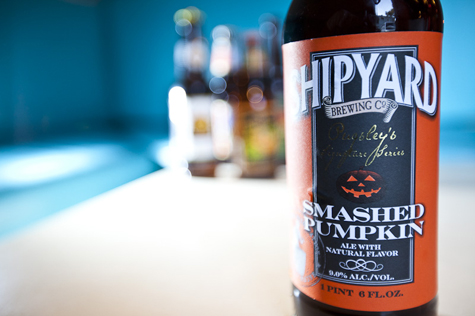
Pugsley’s Signature Series: Smashed Pumpkin Ale
Shipyard Brewing Co., Portland, Maine
Caution: double entendre approaching! Shipyard Brewing Company’s co-founder and Master Brewer Alan Pugsley has outdone himself with this Smashed Pumpkin Ale. Not only will you be “smashed” after a few of these, but your head will feel like Gallagher took his sledgehammer to it in the morning. Packed with so much spice, pumpkin, hops and malts and 9 percent alcohol, this pumpkin beer is truly a trick and a treat. Submerge asked local beer guru Mark Neuhauser of Pangaea Two Brews Cafe what he thought and he called it “very sweet…pumpkin pie in a bottle.” Pugsley uses three different malts including Pale Ale, Wheat and Light Munich along with two different kinds of hops; Willamette and Hallertau. The high alcohol gives it the backbone and bite, making this beer perfect for any of your spice filled holiday foods.
Of course, it’s no surprise that Shipyard would blow the stem off the pumpkin beer category. These guys are known for amazing craft beers that they’ve been perfecting since 1992. They’re Maine’s largest brewery that also makes Capt’n Eli’s Soda, a craft soda that comes in seven different flavors and are the 19th largest craft brewery in the country. All that from little ol’ Maine, go figure. On top of that, Pugsley is kind of a rock star in the East Coast microbrew world. Back in the ‘80s he bounced around and helped establish quite a number of breweries as well helped design and build breweries in the United Kingdom.
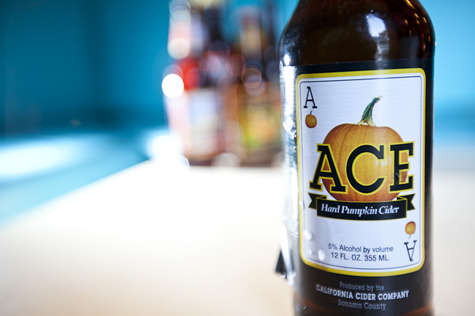
Hard Pumpkin Cider
Ace Cider: The California Cider Company, Sebastopol, Calif.
Alright, here’s your wild card. Ace Cider based out of Sebastopol, Calif., has been making cider for 15 years. Before there were really cider options, there was Ace and over the years they’ve stayed amongst the companies making really high quality, gluten free and delicious ciders. This year is the first year that the company has released their Hard Pumpkin Cider, an apple-based cider that is blended with pumpkin and allspice. Jeffrey House, owner and master cider maker, says that he made 10,000 gallons this year and it’s already all gone.
“People are racing to drink it,” says House.
With the popularity of the product, House says they’ll more than likely double or even triple production next year to meet the demand. The cider is quite a unique product that doesn’t scream pumpkin but merely suggests it. The allspice is subtle and you pick up the apple on the finish along with an interesting aftertaste reminiscent of pear candy. This cider is 5 percent alcohol and quite low in sugar content, 9 grams per 12-ounce bottle. If you’re really aiming for pumpkin, I’m not sure if this is for you but overall a tasty cider that fits in perfectly with their existing line.
These beers and ciders can be found at Total Wine, Whole Foods, Corti Bros and other select specialty markets. Call ahead because they are seasonal and will disappear quick.
Still thirsty for more pumpkin beer? Pangaea Two Brews Café has Dogfish Head’s Punkin Ale on draft. Pangaea was lucky enough to acquire three of the six kegs allocated to the entire Sacramento area, so get it while it’s here. Or, head over Alley Katz and try a Double Pumpkin Ale on draft from Sam Adams.
[Editor’s note: We here at Submerge were devastated to hear of Daniel’s passing on April 8, 2017. His impact on Sacramento’s music and art communities will never be forgotten. Rest easy, old friend.]
The P and 21st block is a sleepy pocket in Midtown. Tucked away from the white noise of the freeways, littered with parking lots and office buildings and a tattoo parlor, it’s low-profile–unless it happens to be a dance night at Press Club or The Townhouse.
Both clubs are infamous alternatives to the posh world of dress codes and bottle service. At Townhouse, or Toho as some call it, the beer’s cheap, the drinks are stiff, the tagged-up bathrooms are claustrophobic and the entire interior is low-lit to obscure seedy behavior. It’s the only spot in town suitable for a dubstep and bass night called Grimey. Being coined by a local DJ who goes by Whores is just another notch in its anti-glamour esteem.
On his birth certificate, Whores is Daniel Osterhoff. He’s Dan to those who knew him before he was Whores. We met at his apartment on the north side of Midtown a few hours prior to Grimey. He does not live in a high-rise loft or a gutted warehouse that doubles as a skate park. He lives like the rest of us, in a modest complex with carpeted floors and enough space to stretch. Two fellow DJs, one of which was Jubilee just flown in from Miami, and Grimey resident photographer Eric Two Percent were hanging out. The walls were like those you’d find at any graf-writer/graphic designer’s abode; dozens of pieces from abstract to lowbrow with the exception being a giant rusted-red W mounted on the wall.
“Russell Solomon of Tower told me the letters were lying around on the roof of Tower Cafe,” Whores said. “So one night I climbed up there and took the W.”
While grabbing me a Red Bull from the fridge he apologized for the hair on the kitchen floor. A stylist friend that was hanging out had sharpened Whores’ close-cut before my arrival.
We stepped outside for a cigarette and chopped it up. It was not long before James Blake’s controversial quotes to the Boston Phoenix that caused a stir in dubstep were discussed. An uber-popular British electro-soul and dubstep artist, Blake railed the genre’s burgeoning “frat-boy market,” which is being labeled “bro-step.” His rant was widely publicized for statements like, “It’s a million miles away from where dubstep started,” and “It’s been influenced so much by electro and rave, into who can make the dirtiest, filthiest bass sound, almost like a pissing competition, and that’s not really necessary. And I just think that largely that is not going to appeal to women.” Periodically throughout the night, Whores and his fellow DJs coolly reminded me that it’s neither their taste nor in step with the identity of Grimey.
The success of the night is owed to the attention to taste, which can be misperceived as snobbery, but should not be construed as such. Even when resident DJ Jay Two approached Whores with the idea of a dubstep night, Whores was interested but hesitant due to a feeling that dubstep had reached its high water mark.
An attendee of Grimey is not given the opportunity to gripe “not this damn song again,” because its resident DJs (Whores, Jay Two and Crescendo) are intent on remaining ahead of the curve by playing records acquired on advance or playing the newest tracks they think need to be heard. It’s a dedication to the cutting edge that is scarce in the local clubs that rely on Top 40 or are just held down by stubborn old dogs disinterested in new tricks.

“I just hold steady with playing what I think people would like,” Whores said. “I’ve attended a lot of different dance nights everywhere from New York to Los Angeles, Seattle, Portland, San Francisco and Oakland. From the most underground to the most mainstream clubs, and I’ve taken little elements from each. But once you get the word out there, the word kind of does it itself.”
Much like fellow local veteran DJ, Shaun Slaughter, Whores is well traveled. He started DJing in 1997 as part of 916 Junglist before moving away in 2000 to Portland. Each move, he connected with different crews in Portland and Seattle before moving back to Sacramento in 2005. “Most people don’t know that about me,” he said. “They just think I came on the scene or think I’m from Portland, but I’m born and raised in Northern California.”
I reconvened with Whores outside of the Townhouse around 9:30 p.m. He was talking with Matt B of Bass Science, who had arrived in a rental from Tahoe. Whores was quick to share his knowledge on Bass Science, practically orating a short bio. “He started the whole glitch hop scene basically,” Whores said. “When Glitch Mob was starting out and Lazer Sword, he was right there. This guy’s got quite a big history in the newer EDM alternative craze.”
All professions have a language and despite my familiarity with Grimey and its music, talking to the actual artists involved meant brief interruptions to ask if they were saying “IDM” (intelligent dance music) funny, only to learn that EDM translates to electronic dance music–the domain in which the sub-genres operate. The confusion then sparked the two DJs into weighing the blurring sciences between EDM and IDM. “Some of it is [IDM] though nowadays,” Whores said. “Some of the juke stuff. Machinedrum’s new album.”
“The Lazer Sword,” Matt B added. “It’s intelligent footwork basically.”
“EDM is basically a very blanketed term,” Whores continued. “Nowadays everybody plays a little bit of everything because people’s attention spans are about this small [makes his index and thumb nearly touch]. So if you play one genre of music, you’re pretty much pigeonholing yourself and boring the shit out of the crowd.”
Whores stepped into the booth at 10 p.m. The bar was filling out and overflowing onto the dance floor with more than just gangly dudes having acid flashbacks from the Jungle club days. Whether it’s the Whores hype, the distancing from “bro-step” and “filthy bass” or just a misnomer, Grimey is never short on female attendees. By 10:30 p.m. the dance floor was gaining steam with a few girls entertaining each other, but come 11 p.m. to 2 a.m. the floor was a grinding, thrusting hot box of sweaty bodies–sweet, sweet uninhibited decadence.
Whores neither bores the crowd nor himself when he DJs. He keeps a folder of over 10,000 tracks on his computer at all times and does not practice a strict set. “It’s a lot more fun freestyling sets,” he said. “Sometimes when I record the sets and go back to listen to them, it’s like, ‘Man, that mix really worked.’ Others it really didn’t work, but what it comes down to is if you’re a professional, you can treat it like a jazz musician and play out of it. It’s all what you do with an error. Some DJs don’t know how to bounce back, they flop or they panic and that shows. That’s the difference between me and some DJ who took it up two years ago.”
Back outside we resumed our interview session in hopes of a quieter haven, but Grimey is the dance night with just as many attendees milling about the roped-off outdoor smoking section and back parking lot as there will be jammed into the dank of The Toho.
Whores clearly enjoys the popularity of Grimey, but he lamented that its success led to the compromise of his HUMP night on Wednesdays opposite Grimey. Originally called Warpaint Wednesdays with Terra Lopez, Whores came on to assist with the DJing and teach her techniques. Once Lopez began Sister Crayon, she forked over the night to Whores who renamed it HUMP.
“It used to be a popular night,” he said. “When Grimey came around it took the spotlight. I’ve been bringing around a lot of relative and instrumental electronic artists and musicians to try to bring it back.”
It was none of my business, but Whores willingly broke down the financial losses he’s incurred in the past two months that’s led to HUMP’s demise. DJs that are not conveniently touring the West Coast are flown into Sacramento and given hotel accommodations on Whores’ dollar. If no one shows, it means he bites the bullet.
San Francisco electronic artist EPROM and Frite Nite’s Salva, two rising beacons in the West Coast, are booked for HUMP at the Press Club this week. After that it’s the anniversary party with locals only in November, including Dusty Brown’s Little Foxes project, which is quite possibly also HUMP’s night of eulogy.
With Fuck Fridays dissolved, the Toho was in need of a new Friday night event, and Shaun Slaughter was back on the market for work. Rather than compete for the local crown, Whores and Slaughter teamed up to create Heater, an exclusive once-a-month party that combines glitter and gutter. “It’s more like HUMP with an open format,” Whores said. “We can play anything from house to electro to Baltimore to indie to dubstep and bass n’ breaks, whatever. It’s just straight party.”
The party debuted last month with the two DJs performing separately, and then trading off tracks for the last hour. “There’s always been an odd tension between us, but we’ve always been super-friendly with each other. I’ve been super-supportive of his nights and he’s been super-supportive of mine. The odd tension was because it’s a small town and he’s held the crown for quite a while. I think we’d really benefit if we did more stuff together, which is why we’re only doing it as a monthly.”
Our vibrations are in good hands with the Grimey residents. It’s a rare event where making requests is the greatest faux pas. “I don’t think it’s common knowledge that people know it’s rude,” he said. “Believe it or not, I have one job and one job only and that’s keep the vibe going. As soon as I stop to talk to someone and they go into detail about what they want to hear and why they want to hear it, all of a sudden they take me out of the groove I’m in, which takes away from the vibe. The next mix I do will be less involved and the crowd will notice, believe it or not. They won’t necessarily think about it like, ‘That mix sucked,’ but just have a moment to consider going out for a smoke.” Put your trust in Whores, kids.
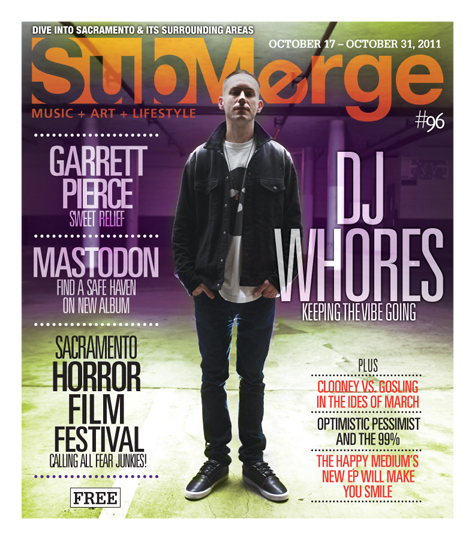
Grimey gets down at the Townhouse every other Tuesday night at 9 p.m. ($10 cover). DJ Whores and Shaun Slaughter’s Heater happens one Friday per month, also at the Townhouse. It’s free to get in before 10 p.m. with an RSVP. You can also catch DJ Whores at the Golden Bear on Saturday nights.
A Lot Like Birds Readies The Release of Conversation Piece
It’s a quiet Tuesday night in Midtown and local progressive/post-hardcore band A Lot Like Birds has 80 or so fans packed into Luigi’s Fungarden as they tear through songs off their upcoming Doghouse Records full-length debut Conversation Piece, set for release on Oct. 11, 2011. Songs like “Think Dirty Out Loud” and “Sesame Street Is No Place for Me,” the album’s first two singles, have the crowd feverishly swaying back and forth to their spastic and energetic rhythms and riffs. Co-vocalists Cory Lockwood and Kurt Travis bounce around the small stage, shaking their long locks, taking turns singing and screaming, fully taking advantage of having co-vocalists (think call and response, harmonizing, layering, etc).
“I’m not the singer and he’s not the screamer,” Travis makes known as the two vocalists and I share a pitcher of Pabst Blue Ribbon at a local watering hole the Friday following the show. It quickly becomes apparent that this is an important point for them to get across. “We’re both vocalists,” he says. “I scream and I sing. And he screams and he sings. And we yell and we talk and we do spoken word. We do everything, we do all of it.”
Lockwood agrees and thinks of it like this, “I feel like a lot of times with dual vocalist bands that have a singer and a screamer, you’re diverging your fans and you’re going to have people that go, ‘Well I listen to the singing,’ and then you’ve got the guys who want tough music and they’re like, ‘Well I like the screaming.’ So if you bleed both of them, you’re forcing people to like it as a whole.”
Couple the outrageous and entertaining vocal work from Travis and Lockwood with the equally impressive instrumental work of the rest of the band, which consists of guitarists Michael Franzino and Ben Wiacek, bassist Michael Littlefield and drummer Joe Arrington, and you’ve got yourself one interesting record in Conversation Piece. One that crosses genres, tears down boundaries, leaves the listener wondering, “What’s next?” after each track comes to a dramatic close, and one that will most likely take a few listens to grow on you. They are aware of this.
“I know that music like this has to grow on people. People are really slow at picking stuff like this up,” says Travis.
“It’s almost easier for us to do weirder stuff,” Lockwood admits.
And weird it is, although we’re not talking about an un-listenable type of weird here; this isn’t just random noise after all. We’re talking about calculated time signature changes, non-traditional song structures, heavy-hitting breakdowns mixed with luscious reverb and delay-ridden clean parts, impressive and off-the-wall guitar riffs and interesting lyrical content to boot. Take the following lines from “Think Dirty Out Loud” for example, where Lockwood screams, “I spiked both our drinks with a gallon of ink / Now I’m writing a novel from your insides / We’re a spider with our limbs doing anything but walking / A conversation with our mouths doing anything but talking.” Or where Travis sings, “I eat emotional wrecks / And yours is the best.”
“I remember the instance in which we started writing the lyrics,” Travis says of the song. “I was totally enjoying myself, just laughing to myself, just thinking I’m the most clever fucking person ever.”
It is noteworthy to point out that in a number of ways, Conversation Piece is entirely different than A Lot Like Birds’ last offering, 2009’s Plan B. The latter was largely the work of guitarist and songwriting catalyst (as well as the band’s original vocalist) Michael Franzino, who invited a horde of local musicians to play everything from trumpet and trombone to cello and violin on the record. Plan B didn’t even feature a live drummer, as Franzino programmed the drums himself via computer. Conversation Piece is much more of a collaborative effort and consists of mostly the band’s core instruments (guitar, bass, drums, vocals), although it does contain some programmed stuff (“A Satire of a Satire of a Satire is Tiring”) and a little bit of horns (“Vanity’s Fair”) as to not depart completely from the band’s tendency to blend live instrumentation with orchestral and programmed elements. One of the most obvious differences between the two records is the solidified lineup, which includes the recent addition of Travis, who up until this summer had spent the last couple years co-fronting another Sacramento-based post-hardcore band, Dance Gavin Dance. “There’s four new members,” Lockwood says of the post-Plan B lineup. Travis interjects, “I’m not the new guy, you know what I mean? I’m the newest by all means. But Plan B was pretty much one or two guys, now this record is everybody giving their opinions and whatnot.”
For the recording of Conversation Piece, A Lot Like Birds turned to Portland, Ore.-based producer/engineer Kris Crummett, a familiar face to Travis, they have recorded two DGD albums together (2008’s self-titled record and 2009’s Happiness).
“As soon as I got kicked out of Dance Gavin Dance, Kris hit me up and was like, ‘Let me know what you’re doing, whatever you do, just let me know,’” Travis remembers. “It was kind of interesting because when I joined A Lot Like Birds, they were already talking about and thinking about going with Kris Crummett. I love that guy, we have a good history; we have a good thing going on.”
The band worked rigorously with Crummett for three weeks, focusing all of their creative energy on the record, which wasn’t even necessarily completely written yet, as Travis and Lockwood both had a fair share of lyrical work to do while in the studio.
“Everybody was hella trippin’, but that’s kind of how I like to work anyways,” Travis says of the high-pressure situation to complete basically half an album’s worth of lyrics on the fly. In the end, things worked out beautifully for the two vocalists, who found themselves locked in a room with Crummett for hours on end, pounding out vocal ideas together.
“I don’t think either of us had any idea how well we were going to work with each other,” Lockwood says of co-writing. “I’ve never worked with another vocalist before.” Travis pointed out that because the group was away from the everyday distractions that come with being home, they were able to channel everything they had into the record. “When you’re in your home town and you have all your stuff, you know, you have your job that you go to, you’ve got your girlfriend, you’ve got your parents and all this stuff. Sometimes it’s distracting,” Travis says. “I hella missed that when I was a full-time touring musician. You kind of just focus on music. So when I got to Portland, I was just kind of like, ‘Ah, I don’t have to think about anything other than just this record,’ and it got all of our attention.”
Even still, the band didn’t finish everything they needed to in their allotted time with Crummett, and they had to record one song in Sacramento with friend and sound engineer Chris Miller. Crummett was still producing even from hundreds of miles away, though, as the band Skyped him during the sessions with Miller.

“He was still there like being able to hear the takes,” Travis says with a chuckle at the thought of Crummett’s face on a computer screen in the room for hours on end.
“He was just like eating Chinese food and shit,” Lockwood says through a laugh while air shoveling a bite of imaginary food into his mouth.
After three weeks spent in Portland with Crummett and a couple more days’ worth of sessions with Miller in Sacramento, the record was finally done, or so Travis thought. “Knowing my luck, we do like two days with Chris and then we get everything done and we’re like, ‘Yes! Fuck yes, it’s done,’” Travis says. “And then I get a call from my guitar player and he’s like, ‘You’ve got to come back and do some more stuff,’ and I was just like, ‘Dude, when is this going to end? We’re not even in Portland anymore.’ But it was completely worth it and the song came out way better than I even thought it could.”
In between the Portland and Sacramento recording sessions, A Lot Like Birds even found time to embark on a week-and-a-half long West Coast tour. It proved a good opportunity to work out the brand new material in the live setting and to gauge people’s reactions to it as well. “It was really like a testing the waters sort of thing,” Travis says. “To see who gives a shit right from the get-go. It was a good response!”
Lockwood recalls one particular night in Anaheim when a girl came up to him at the merch table after the show and told him that she hadn’t heard music like theirs in years, since the early ‘00s. “That’s definitely when I started playing music, that’s when we both started getting really into it. So if anything, if we draw comparisons to stuff from back then, that’s all I’d love to hear.”
Unfortunately for A Lot Like Birds, references to the sounds of the early ‘00s aren’t the only comparisons they’re receiving, as a large number of people (mostly via the Internet) are saying they sound too much like Dance Gavin Dance. No doubt there will be comparisons: both bands are from Sacramento, both have two singers, both have ripping guitar players and rock-solid rhythm sections; heck, they even recorded with the same producer, so yeah, sonically speaking there are some similarities too. But what’s funniest to Travis and Lockwood about the whole situation is that these quick judgments are coming from the album’s two singles, because those are the only two songs off Conversation Piece that the general public has heard.
“People have been really quick to go, ‘Oh, this is what their whole album is going to sound like,’” Lockwood says.
“They don’t even know how versatile it is,” Travis contends. “You know how the Internet goes; people are very, very quick to judge. It’s funny, it’s almost tickling. They have no idea. It’s going to be cool, because they’ll realize it when it comes out.”
Travis also wanted to get off his chest how he feels for Lockwood, who seems to be receiving the brunt of the reviews. The problem? Apparently he screams too much like Jon Mess, DGD’s co-vocalist. “Dude, if you have ears, you would know that it’s completely different,” Travis demands. “Their screaming styles are completely different. It’s just kind of like Jon Mess is the only person they can reference. It’s so funny, like when people compare me to Jonny Craig [DGD’s original vocalist who replaced Travis when he re-joined the band this year], it’s like, ‘Are you fucking retarded? Do you actually have ears? Because I sound nothing like him.’ Not that I couldn’t sing Jonny’s stuff and not that Jonny couldn’t sing my stuff, it’s just, we don’t sound alike. It’s the same thing with Jon Mess and Cory, and I just feel for him.”
Travis has gotten his fair share of attention, too, ever since his departure with DGD. “It’s just something that you have to deal with,” Travis says of constantly being asked about his situation. “It’s like one of those things about your job that you hate but you have to do anyways. I kind of relate it to that, because no I’m not upset, no I’m not tired of it. It’s just one of those things that I know that I’m always going to have to address and that’s fine. If I didn’t have all of that then I wouldn’t have any of this amazing stuff that’s going on right now. So, I think of it that way. Not like, ‘Oh man, I don’t want to talk about the past.’ All of that shit needed to happen in order for this amazing stuff to happen. I look at it like that so I’m not upset when someone is like, ‘What was it like? You got kicked out! Blah blah.’ I’m like, ‘Yeah, I did, but things worked out.’” And if you’re wondering, everything is cool between all the members of DGD and A Lot Like Birds. So much so that the two bands will share the stage together on Thursday, Oct. 13, 2011 at Sacramento State’s University Union.
After weeks spent listening to an advanced copy of their new record, an hour spent over beers at a local pub and a killer live set witnessed, it’s apparent to Submerge that A Lot Like Birds are their own band with their own identity and their own sound. Conversation Piece is no doubt the record that will solidify that and as of right now, getting the album out and into the hands of people who care about it is the only thing on their minds. With a grin from ear to ear, Travis says, “I think things will pop off real fast once that happens.”
A Lot Like Birds’ Conversation Piece will be out on Oct. 11 via Doghouse Records. See them live at Sacramento State’s University Union Ballroom alongside Dance Gavin Dance on Oct. 13. Sacramento’s own Ten After Two will also perform. Tickets are available at the University Union Box Office.
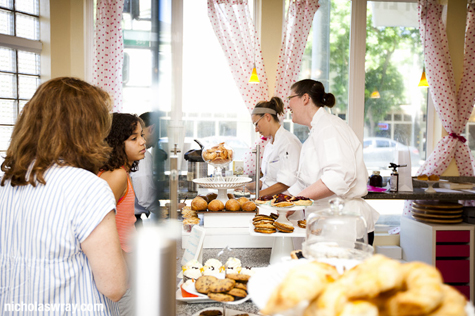
Sugar and Spice Specialty Desserts
1201 F Street – Sacramento
Words by Adam Saake | Photos by Nicholas Wray
Pastries, I believe, are the truest product of epicurean excess that have never fallen out of favor like many cooking and baking trends, but rather have gained popularity. We turn them away because they’re “sinful” or pass because we’re trimming the fat, but in the end we succumb and rarely are we disappointed (if only just a touch guilty). Recipes for cakes and cookies, scones and muffins are endless on the Web, and TV shows suck millions of viewers in with racy food porn in the form of decadent icing and exotic flavors. We’re eating it up–literally. Sacramento is no different and our options to satisfy our own sweet cravings just keep getting better.
Pastry chef and owner of Sugar and Spice Specialty Desserts, Carissa Jones, opened up shop in January after building the business for three years with encouragement from her father.
“My Dad has always owned his own business and he said, ‘You need to do what you’re passionate about. If you do what you’re passionate about, then you’ll be happy,’” she says.
With her undergraduate degree, “living the dream” wasn’t paying the bills. And it also wasn’t making her happy. After working in the financial industry for far too long, the day came to put the icing on the cake.
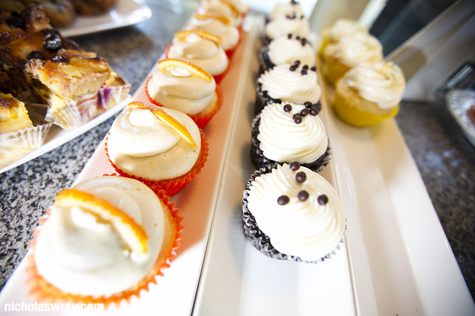
“I had a really bad day at work, which is all it takes sometimes to be that catalyst for change,” says Jones. “So I went and talked to the California Culinary Academy and I started three weeks later.”
Her historic shop is boutique and quaint–a corner spot on 12th and F in the Alkali Flats neighborhood that once upon a time was a pharmacy. The light rail tracks are parallel to her street-side window. As we spoke, a train passed by, a yellow and blue blur that shook the shop momentarily, causing the orb-shaped paper motifs dangling from the ceiling to bob and sway. Pink polka dot curtains flanked the windows, luring curious pedestrians and 12th Street traffic into the tiny lobby where a display case full of tasty treasures awaited. Regulars were in the shop, picking up an item or two on their lunch break from maybe the neighboring state EPA building or the courts that are only a few blocks away. Now that folks know that she’s there, Jones says she’s been getting some special requests.

“I had a gal come over the other day and she wanted to do a thank you for a girlfriend; she’d bought her this lip gloss called Pink Cookie. She came to me and said, ‘I need you to take any cookie you have and make it pink,’” remembers Jones. “So we did a mixed berry butter cream on top and some pink sprinkles with some white chocolate. We boxed it up all pretty and she was tickled.”
On the afternoon of my Wednesday arrival, Jones was busying herself with a batch of peculiar and wildly seductive cupcakes–cupcakes in the shape of breasts. I bite my tongue in restraint of the plethora of jokes that might occupy the next couple sentences, and I can only imagine what might come to your mind. Pour some ice on it and relax, because Sugar and Spice isn’t a Silicone Valley pastry shop. Jones wanted to be sure that was clear.
“Don’t take pictures of these by the way. I don’t want this to be what we’re known for,” says Jones, half serious.
But the cupcakes are for a party–a bittersweet party where a female customer will be saying, “Goodbye to her boobies.”
“She’s having a radical mastectomy. This is her second round of breast cancer and so these are favors for the party,” explains Jones.
Jones should be known for her “booby” cupcakes, because it’s a perfect example of the kind of transcendence that something simple and sweet like a cupcake can achieve. Jones is shaping Sugar and Spice to be the kind of business that caters to the customer, to the hopeful survivor, to the vegan wedding guest and to the passerby who is simply craving a tart.

Jones’ selection covers much ground. Croissants, crème brulee and cream puffs anchor a pastry menu that offers the classics, reinvents the usual and even adds a bit of kitschy fun. For example, a must-have is the s’mores pop tart with house made pastry dough, graham cracker, chocolate ganache and topped with a slab of marshmallow that is toasted per order. Look out, girl scouts ‘cause this s’more is grown up. Also, be on the lookout for anything with fruit in it, especially if it’s seasonal. Jones makes frequent trips to the farmers market to hand select fruit, and that means that the freshness and sweetness will be on point.
Sugar and Spice is available for weddings, special orders or unique requests. Whether you desire something elaborate or simply must have a peach cobbler, Sugar and Spice is a destination well worth your investment. And try not to feel guilty, because I sure as hell never do.
Bartender Jayson Wilde finds a potent way to harness his creative energies
Words by Anthony Giannoti – Photos by Nicholas Wray
Have you ever wanted to quit your perfectly good 9-to-5 job to pursue your passion? Well in May 2009 that is precisely what Jayson Wilde did when he quit a good job to learn how to be a bartender. To explain why he threw away 10 years at a good company, Wilde said through his patented goofy smile, “Full benefits are great but being happy is better.”
And happy this guy is, in fact he is one of the happiest guys I’ve ever met. His natural good cheer and hard work has led him from never having stepped behind a bar to being a manager at one of the top 10 bars in America within two years!
This Sacramento native started his quest at Midtown’s very own Shady Lady Saloon. “I would hang out at Shady with my Bartender’s Bible and just bombard the bartenders with questions,” he said. “After a month or two of that they were like, ‘Do you want a job here?’
Wilde had to put in his dues, starting at the bottom as a lowly bar back. “I broke a lot of glasses,” he said with a laugh. “But those guys were super supportive and taught me the ropes.” This may have been a relatively short road for Wilde, but it was not an easy one. “My first year I was working pretty much seven days a week and any days I had off I was going into the city [San Francisco] to try out new bars and new drinks. I was trying to learn as much as I could so I could bring it back to Sacramento.” With hard work and ambition he was able to challenge and improve his palate. After a year or so of this, Wilde was given the chance to work at one of the best craft cocktail bars in San Francisco and arguably one of the best bars in the country, Bourbon and Branch. Six short months later he was promoted to bar manager and since then has done guest spots all over California, cocktail demonstrations at the W Hotel in San Francisco and was recently named one of SF Weekly’s New Generation of Bar Stars.
I had a chance to sit down and talk drinks with the cocktail whiz kid at the scene of the crime, Shady Lady Saloon.

What got you interested in tending bar?
Well, I had been working at an insurance company for about 12 years, and it was great because I had full benefits and five weeks paid vacation. The vacation time was great. When I was playing guitar with Whiskey Rebels, I could do a ton of touring. But that started to fizzle out. Everyone started getting married and doing the mortgage thing. I realized I needed to do something that allowed me to be more creative, because the insurance job was going to make me murder myself. [Laughs] I was going to kill myself. I have a creative drive. That’s how I have fun, and the insurance job wasn’t going to allow me to have any fun. I knew the guys here at Shady, and they were kind enough to let me step behind the bar, and I fell in love with it.
What exactly made you “fall in love” with bartending?
When I stepped behind the bar I was like, “This is so great. I get to talk to people and have a good time.” I still had an audience just like playing music. I’m still being creative just like music–instead of writing a piece for a song I’m writing a piece for a drink and pleasing my customers.
How do you feel about being called a mixologist?
It’s bartender. I feel like the whole mixology thing…I get it, whenever anyone says that to me I’m not like, “No, no, no, listen here son.” I don’t correct them. Being a good bartender is all about being humble and making sure that the customer is having a good time. I don’t want anyone to feel like, “This guy right here in front of me is amazing and makes all these things that are great.” I don’t want to be put on a pedestal. I’m not doing as much for society as a teacher or anything. I just make drinks, and we have a good time together. The term mixologist makes everything seem so serious, and that’s not what being behind a bar is. I don’t wear a lab coat.
What are the components to a good cocktail?
There are three major things to making a great cocktail: The first thing is appearance. It’s true what they say, you feast with your eyes first. If you see something that looks appetizing it’s going to boost your interest, “That looks awesome, it must taste awesome.” Second is smell–you get a lot flavor out of your olfactory sense, your upper palate. It’s got to smell enticing. If you have a cocktail that has egg whites in it, and it smells like eggs, it may taste good but it’s going to give the wrong sensory impression. Third, obviously it’s got to taste great. Just like a chef puts a meal together, a drink should have complementary flavors and not too much of this or that, balance is key. Don’t just grab spirits and try to force them to work together. Think about cooking a meal or desserts. What flavors do you know already go together? Use ingredients that make sense: apples and cinnamon, raisins and rye–a lot of times if there isn’t a drink that uses certain ingredients, it’s because they don’t go together. Don’t try to reinvent the wheel.
Where do you get the inspiration for some of your more unique drinks?
I get a lot of my inspiration from cooking. I like going to a restaurant, not to rip them off but to get inspiration. It’s like music, when you hear a good song with a part you like, it can inspire you to write something. When I have a drink I like, maybe with rye, I try to think, what can I do with this but use rum? Or some things I’m just walking through the grocery store and I see like a chocolate bar with chili peppers in it I’m like, “Wow that’s cool, how can I make it into a cocktail?” I try to keep an open mind but honestly it’s all trial and error.
So do you have a favorite to make?
As cheesy as it sounds, my favorite drink to make is the one that will make the patron feel the most excited about what they are about to have. It doesn’t matter whether I make a vodka soda or an elaborate six-ingredient cocktail. It matters when I hand the customer a drink and they say, “Perfect, exactly what I wanted.” Having people like what I make makes me the happiest.

Have you seen any new trends in what people are drinking or bartenders are making?
A lot of people are starting to move onto this room temperature cocktail thing or barrel aging and stuff like that. It’s interesting as a fad, but it’s not something I think will stick around. If someone hands me a room temperature drink I’m going to be like, “Really? It’s warm, I want something refreshing, cold and nice.” I have noticed a lot of bars are moving toward the slow food thing, the farm to table mentality, which is great to see. There are a lot of smaller cities that are getting into it. Sacramento has really been stepping toward fresher ingredients.
Speaking of the Slow Food Movement, you are doing a guest spot at local slow food restaurant, Grange, for Midtown Cocktail Week. What is the concept or theme if you will?
Complete and utter mayhem in the funnest way possible, that’s the easiest way to put it [laughs]. Ryan Seng [resident Grange bartender] and I have been getting together to construct a cocktail menu for a vintage carnival theme. What we mean by that is we are taking carnival foods: cotton candy, cracker jacks, snow cones and all the interesting fun carnival stuff and putting them in cocktail form. We also hired a really cool French noir-style act from Oakland called The Vespertine Circus, to perform during the event. So basically we will have a free punch for you when you walk in the door and mayhem will follow. It’s going to be super fun, no frowns allowed. No sad clowns allowed!
What tips do you have for the home bartender?
Have a good time. Start out with simple stuff and don’t try too hard. Try making an old fashioned, get your bearings. Another good thing would be to get a bartending book. Scott Beattie has a great book Artisanal Cocktails, or Jerry Thompson has good stuff too. Be adventurous but keep it simple. Try new things. That’s what spirits and food is all about, being fun and adventurous.

Midtown Cocktail Week is Aug. 15—21, 2011. Jayson Wilde and Ryan Seng will host an event at The Citizen Hotel Ballroom on Aug. 19, 2011. “The Greatest Cocktail on Earth” will feature carnival-inspired drinks such as The Bearded Lady and Strong Man as well as others. Admission is free, and drink tickets will cost $8. For more info on Midtown Cocktail Week, go to Midtowncocktailweek.org.
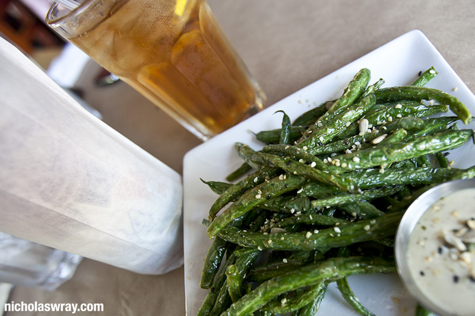
The Garlic Shack
1830 J Street – Sacramento
Words by Adam Saake
Photos by Nicholas Wray / Nicholaswray.com
You may have driven by the corner of 19th and J streets and noticed that Plum Blossom is no more, and in its place is the newly opened and curiously named Garlic Shack. I’ve heard mixed feelings from folks about the closing of Plum Blossom; some couldn’t care less and never went there and others were bummed because sweet and sour chicken was “awesome” at 3 a.m. after seven shots of Jameson. Plum Blossom was a fun place, I agree, but I wouldn’t judge a place’s merits by how late it stayed open. And, if that’s all you’re bummed about, Garlic Shack is open late Thursday, Friday and Saturday to cure those late-night cravings. That deserves another round.
Before I begin, please do yourself this one little favor and stay off of Yelp before you try this place out. It’s OK to make up your own mind about restaurants, and for crying out loud they just opened. I am in no way discrediting Yelp or Yelp users (I used to be one before I began writing this column) but the lack of little stars can be harsh on new restaurants. Submerge prides itself on elevating the awareness and interest in all things Sacramento, and the “Refined Tastes” column is no different. I seek to tell you about places Sacramento loves or places that are new and worthy of checking out. Garlic Shack falls into the latter category, and it is up to you to decide if it falls into the former. Pardon me as I step down from my soapbox.

Submerge visited on a Monday afternoon; hot but not miserable and the newly installed roll-up door was wide open, giving the stoplight voyeurs something to gawk at. The table tops were draped in brown butcher paper and a glass of crayons rested in the middle. Our server grabbed the color red and in big cursive letters wrote her name, “Dre.” “I’m Andrea but my friends call me Dre,” she said with a smile from ear to ear. “How about we start off with the Nor Cal Green Beans,” she continued. Flash fried green beans tossed in hemp, sesame and sunflower seeds and served with a wasabi balsamic aioli dipping sauce. This dish was phenomenal and was a good indicator for how the rest of the menu might taste. Bold flavors and adventurous plates are the theme here, and it’s no surprise considering that garlic is in the spotlight. This isn’t The Tofu Shack (although they have some of that too); we’re talking about the stuff that wards off vampires here.
“We’ve been…trying to give them more garlic,” says owner Kenneth Powers. “It says it in our name, and they can’t get enough of it.”
And so garlic is integrated into many of the dishes, where it can be the star and leave you reaching for the breath mints or where it simply is used to accent what’s on the plate. The special on that Monday was a beer-battered waffle with roasted garlic, caramelized bacon and offered with fried chicken, if one would be so inclined. Inclined we were because it’s not smart to pass up chicken and waffles, especially when there’s bacon and garlic involved. This dish was not for the faint of heart but for the hearty enthusiast. The chicken was smaller pieces of tender and moist breast that were fried in a light batter, while the waffle contained bits of the roasted garlic. Strangely, the garlic was integrated so well into the batter that I almost didn’t notice the texture until midway through eating. I know what you’re thinking right about now–garlic in waffle batter? Yes, and chicken and bacon and syrup. Oh my! Again, a heavy and adventurous plate but fun and executed well.

For those with a lighter palate, the Daphne offers balsamic glazed portabella mushrooms with tofu, garlic mashed potatoes and fresh veggies. Pork lovers can get excited about the West Coast Philly, a new spin on a classic. Take away the cheese steak, add thinly sliced pork loin, Dijon glaze, sautéed mushrooms and onions and then top it with mozzarella on a ciabatta roll and you’re sittin’ pretty.
With the heavy to the light, Powers likes that he’s able to showcase two sides of people’s eating habits.
“We’re not trying to please everybody, but we’re trying to let more people know that people are aware of their diets. You can get the greasy food; you can get it greasy and deep fried or you can get it steamed with brown rice.”
The range of menu items that are all pretty interesting and made with fresh, local ingredients makes this place worth checking out. Taking your time to look over the menu will benefit you, because it’s not really laid out into obvious sections. There are sandwiches, burgers, wraps and entrees but you may need to read a little to figure that out. Local beers are offered, but I recommend the house-brewed ice tea. Ask for the simple syrup to sweeten it up a bit. And no, it’s not garlic tea.
Rail Bridge Cellars has new vision, same loyalty
Words by Adam Saake – Photos by Nicholas Wray
As the large, roll-up door of the 6,000-square-foot warehouse off North 16th Street noisily opened, two Michaels met myself and Submerge photographer Nicholas Wray with wide smiles.
“Hello,” they said, apologizing for the door not being open all the way for us upon our arrival. “We’re a little temperature conscious around here,” they joked.
The two are Michael Gelber, owner of Rail Bridge Cellars, and Michael Chandler, one of only three level-two sommeliers living in the Sacramento area and brand developer for the winery. Behind them, French oak barrels filled with aging wine, a handful of them new French oak, were stacked four-high on racks that stretch to the ceiling. It’s a hell of lot cooler in the winery than it is outside, a steady 55 degrees, which is crucial for the aging and storing of the wine. In fact, everything about the wine takes place right there in the urban winery, Sacramento‘s original urban winery, says Gelber. From the crush to the fermentation, aging to the blending, Rail Bridge Cellars is the real deal. The only thing that isn’t done there is the growing of the grapes, but that’s not an issue.
What makes an urban winery successful in creating great wines is immediate access to good fruit. A winery like Rail Bridge can source their grapes from nearby wine growing regions that are each just under an hour away. Plus, because Rail Bridge’s production is so low (they bottled about 1,400 cases this past April), the availability of higher quality grapes becomes easier, giving them access to just about whatever they want. For now, 90 percent of the grapes they buy come from the Napa Valley, the Oak Knoll AVA (American Viticultural Area) to be exact.
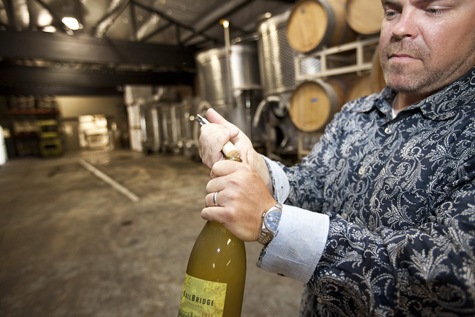
Three of their five reds are blends and that can be a delicate science where too much of one thing or not enough of another can make a world of difference. So being particular about what grapes they select and what AVA they come from is crucial. A wine like their 2007 Lattice Cabernet Sauvignon Reserve is blended with Cabernet, Merlot and Cabernet Franc, which all spent two and half years in French oak. Rail Bridge’s Cabernet Franc shines brilliantly in their blends, even though its percentage can be as low as 1 percent, such as in their Merlot. With the Lattice, it calms the big tannins of the Cabernet Sauvignon while putting a feather in the hat of Merlot.
The fruit may be sourced locally, but the blend and the palettes behind this wine and others like 2007 Right Bank, a blend of Merlot and Cabernet Franc, are certainly Bordeaux. That influence stems from the first winemaker and creator of the winery, Jon Affonso. Affonso’s winemaking experience brought him “to Chateau Angelus, a Premier Grand Cru winery in St. Emilion, France, where he learned traditional French winemaking techniques,” explained Gelber. “He really understood Bordeaux wine and blending.” From there he worked in Sonoma and Napa at various wineries before he decided he wanted to start making his own wine and to start a winery that would live right here in Sacramento.
Affonso gathered some investors, and Sacramento’s first urban winery was born. From there, the story sounds a lot like that of so many other talented winemakers and amazing wines that have come and gone throughout the years. All the components were there for success except the one thing that really keeps it all going: money. The investors decided they were no longer going to support the venture and the hand was on the plug, ready to be pulled. Enter Gelber, Chandler and new winemaker Ron Runnebaum. “Hand off the plug!” they exclaimed with gusto. It wasn’t quite that dramatic, but you get the point.
Why save a sinking ship? Well it depends on what’s on the ship.
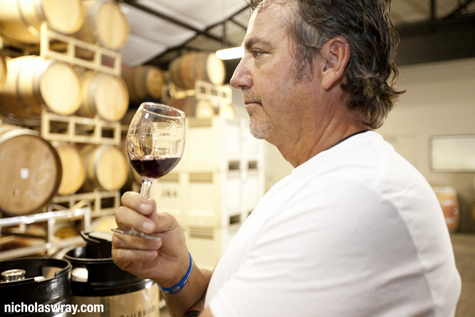
“The whole of it was worth more than the parts,” said Gelber on stepping in to take over Rail Bridge. “The truth is the wine, name and fact that it was Sacramento’s first urban winery were the reasons why it made sense to keep it going.”
With Gelber and Chandler breathing new life into the winery, the next step was to make it their own. Starting from scratch may have set them back a bit on re-launching the brand, but they didn’t have to deal with that.
“When we took it over, we had a ton of juice in here that was already harvested, was fermenting and barrel stored,” said Gelber.
Chandler, whom Gelber described as “the face and the nose of the winery,” was brought on to manage the brand. First thing he did was assess all that “juice” they had inherited as well as look at what Affonso had created before and how they could improve upon it. Affonso was making two wines: a Lattice (meritage) blend of Cabernet, Cabernet Franc, Merlot and Malbec as well as a white–Sauvignon Blanc. Chandler didn’t like this one bit, and for good reason.
“The biggest issue was, you make a Sauvignon Blanc and Meritage, the two hardest wines to sell on a retail wine shelf and restaurant wine list in California, if not definitely our region. So why are you only making wines that are the two hardest things to sell?”
No sense in making a waste of good juice; all they needed was a little reinventing.
“The reputation for the wine was good, but needed more variety,” said Gelber.
Wine varietals in the United States need only contain 75 percent of the named variety in order to be called that. Fun fact and something to look out for when drinking wine, because your bottle might not have the pedigree you think it does. In Rail Bridge’s case, the French Bordeaux influence was retained (even with new winemaker Runnebaum, who interned in Burgundy) and the blends are what make the pedigree. In addition to the 2006 and 2007 Lattice and 2007 Merlot, there is also their Right Bank wine. With a blend of 61 percent Merlot and 39 percent Cabernet Franc, this wine has become a favorite among consumers. What’s interesting too is that not only are the wines of Bordeaux’s right bank consistent with this blend, but Right Bank happens to also be a reference to Sacramento, which lies on the right bank of the Sacramento River.
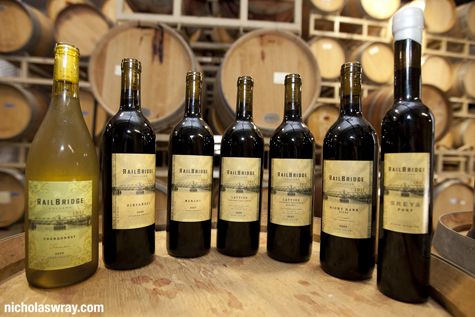
In addition to stretching out the blends and creating new wines, Chandler also added a Chardonnay called “Sienna,” which is named after Gelber’s daughter. Chandler wants to take Rail Bridge’s Chardonnay in a different direction, away from the big buttery wines that have been made popular by giants like Rombauer. He’s aiming for a brighter, more crisp and acidic Chardonnay but still with a considerable backbone. He aims to reinvent their Sauvignon Blanc program as well.
“People were getting away from Sauvignon Blanc because it was too lean and acidic,” said Chandler.
But he feels there is a return, and he’s hoping that will be good for Rail Bridge and the sales of their Sauvignon Blanc. So far, he’s off to a good start. Rail Bridge wines can be found at Ella, Biba, some of the Paragary’s locations as well as the wine department of Bel Air grocery stores. Chandler is also championing another interesting new addition to the retail wine world: wine kegs. Specially designed kegs with plastic liners that hold 15 bottles are on the Rail Bridge agenda. Magpie Catering is already on board and larger clients are in the wing. Move over Red Bull backpacks, because the keg can be strapped on, making filling and re-filling mobile. Be on the lookout for Rail Bridge opening up in a new space inside the historic Elk’s Lodge building located off J Street in downtown Sacramento. A VIP tasting room in the penthouse will be open for reservations as well as private access to club members.
The I Street bridge that is featured on the Rail Bridge Cellar label is significant for its iconic Sacramento imagery but also signifies the linking of Sacramento to the wine country. The bridge passes over the Sacramento River and connects travelers to Yolo County, Napa and Sonoma where wine is a religion. Gelber and Chandler have great pride for their city and a Q and A on their website states that, “We think a wine begins with a simple question ‘What does Sacramento want to drink?’” It sounds like a great start to Rail Bridge’s new beginning.

For more information about Rail Bridge Cellars, including their list of wines, go to Railbridgecellars.net.
Kill the Precedent load up with a new EP
Industrial metal might conjure images of military-like precision with perhaps a totalitarian-style frontman at its controls. Kill the Precedent certainly evokes those images with their music. Thundering beats–both live and electronic–blast behind thrashing riffs and the two-pronged vocal attack of Twig the Exfoliator and The Ugly American. However, speaking with the two vocalists in a recent interview, the guys seemed jovial, bordering on jolly. For instance, if you were to call The Ugly American’s cell phone, you might hear The Dead Kennedys’ classic “California Uber Alles” playing while you waited for him to answer your phone. He said that since Jerry Brown was re-elected as governor, it seemed appropriate. “It’s such a fucking mess out here,” he quipped. “I thought it was pretty damn funny. At least it’s not an actor.” If KTP was indeed an army, in demeanor, they’d be more akin to the cool jokesters from Stripes than the cold-blooded killers of Full Metal Jacket.
Make no mistake, though; the band’s music is a no-holds-barred aural assault. KTP is ready to release a new EP, Stories of Science and Fantasy, which will consist of six original songs and two covers (The Smiths’ “Death of a Disco Dancer” and Jessica Lea Mayfield’s “We’ve Never Lied,” which Twig says was recorded in a hotel room in Oakland). Evoking the days when bands like Ministry and KMFDM crashed mainstream rock’s party, songs such as “Questions for Weapons” wield an imposing arsenal or metal riffs and huge beats, courtesy of electronic beatsmith/guitarist Hamburger, guitarist Killsbury and drummer Sgt. Pepper, while “Free Reign” is a throbbing, almost dance-y track highlighted by Jon the Jew’s pummeling bass line and an underlying, monolithic electronic groove.
Members of the band are no strangers to the Sacramento rock scene. They have played in bands such as Red Tape, Diseptikons and Rivithead in the past, but Kill the Precedent started as a side project of The Ugly American and Hamburger.
“Hamburger and I got together in 2006 and started screwing around with the drum machine,” The Ugly American explained. “We were kind of doing a little Big Black kind of deal, just having some fun. We recorded some music and got a hold of Twig, and I said, ‘I got to record some vocals, can you come down and help me out?’ We recorded vocals. Twig and I had been friends for many years, and he was giving me this blank stare, so I was like, ‘OK, you didn’t like it, but thanks for coming down and recording.’ And he said, ‘No, I want in. I’m fucking in.’ He took over from there.”
Twig’s introduction to the band was through the song “Cop Out,” which will appear on Stories of Science and Fantasy. More songs were started, but Twig said they were left unfinished. As each new member of the band became a permanent fixture, the songs began to flesh out.
“I wanted Killsbury to put a guitar riff over that–just that one song [“Cop Out”],” Twig said. “I’ve been in bands with all these other people in Red Tape and Diseptikons, and I was like just do this one song, but then it became do this song and that song…and eventually that’s how each member has come to be in the band.”
For The Ugly American, Kill the Precedent became a way of rediscovering the music he loved to make in the late ‘80s and early ‘90s with bands such as Rivithead and Battalion 53 after years of playing in punk bands.
“It dawned on me that I really missed that shit,” he said. “It was powerful, it was fun, it was endless. You could do whatever you want and get away with a hell of a lot more.”
In the following interview, KTP’s two vocalists fill us in on the making of the forthcoming EP and what draws them to making this kind of music. We find out that the reason why the harsh-sounding vocalists are so jovial is because they’re playing music they actually love.

It seems like industrial is a genre of music that’s gone back underground. Is that part of the excitement of revisiting it?
The Ugly American: Kind of, but not really. There’s no denying that those bands have had an influence. It’s obvious–and it should. It’s fucking awesome music… I can just say I missed the power of it.
Twig the Exfoliator: I liked the freedom of it. When we first started jamming around, with Jeremy from the Snobs, the bass player, was doing a bunch of electronic beats and me and [Ugly] would sing over it. It wasn’t hip-hop singing, but it was like a Fugazi overlay over dance music. I definitely wanted to not do just Ministry type stuff, but I wanted some melody in there to make it a bit different.
Listening to the music, you can definitely hear that sort of punk-type melodies.
Twig: Whatever [Hamburger] makes up beatwise and gives to us, half of them could be more on the dance side, some of them are more hard and fast, or slow and driving. If we hear something that we like, we’ll get working on that. Part of the reason why I wanted to do this was because I didn’t want to work with drummers anymore [laughs]. I was mad at all the drummers I’ve ever played with, and they take too long to set up. I was sick of loading all their shit into my van. That was the original idea, “Oh, we do whatever. We don’t need a drummer. Be like a hip-hop band, just plug in an iPod and do it like that.” That’s the way I wanted to do it. I wanted to put on a big production of a show, but within our budget.
Ugly: When Twig was on tour with Hoods–I think they were in Europe. He was adamant about it. He was like, “No drummers. I don’t want any fucking drummers.” Before we even put a drummer in there, I wanted one, because I wanted to add to the power and the beats and make it sound as large as we could. But he was all, “Hell no, we’re not doing it.” So, he goes to Europe and we grabbed our old buddy [Sgt.] Pepper. We brought him in to practice while Twig was gone. When he got back, he showed up for practice, and we were like, “Oh look, it’s…Pepper.” He was like, “You dick.” [Laughs.]
Twig: [Laughs] But it worked out.
Twig, you said you came in and did the middle section of “Cop Out,” but after doing that you wanted in. What drew you to this project?
Twig: I wanted to do something different. I wanted to do drum machines and just sample stuff by myself, but I’m completely computer illiterate. I don’t know how to do any of that stuff, and I couldn’t get anyone to do it. I talked to [Ugly], and they were already doing it for a couple of months, so I went in to record with them. The beats were big and huge, and it was something different. Since he let me even try something, and I could overlay a couple different vocal layers, and me and Sean could go back and forth instead of having to write a song’s lyrics all by ourselves–and you know, run out of breath–it made it better that we could share the vocal part. I liked that. I liked who he was working with, because I had known [Hamburger] from Rivithead and Battalion 53. We were also working with Evan at that point, Tha Fruitbat.
It seems like everyone who has come into the project has left their own stamp on it. Is that how the songwriting goes or do you start with the beats and go on from there?
Twig: Hamburger does all the beats and stuff. He’ll do two different parts with maybe some guitar, because he plays guitar too. He’ll just send us two-minute loops so we can get an idea about it. Then usually we will come up with singing structures, and then we’ll leave it alone. We won’t finish anything, and then we’ll bring it to practice and everyone else will listen to it and have their input. We start arranging the songs from there, cutting out parts, changing the drum beats, adding different parts, then we actually start writing the songs, the lyrics and stuff.
Ugly: It goes in reverse. It’s not the typical way you write a song, but it’s totally working for us.
Twig: Everyone’s really busy, so it’s all sent over the computer. Hamburger will send the beats to us, and we’ll pick the ones we like–the whole band will. And we’ll just work on it from there.
A lot of the bands we were talking about as influences before are largely associated with one guy, like Al Jourgensen for example, but it sounds like you guys actually play the songs to write them, which I think is kind of interesting for industrial music.
Twig: It’s like any other band. We’ll start arguing…but it all works out in the end as long as no one’s picky and tries to be the highlight of the song. Everyone knows their place.
Ugly: There are no egos, arrogance or bullshit. I know this sounds hokey, but it’s a completely collective effort. Everyone has their say. Like Twig says, we’ll argue to friggin’ death over it, but everybody’s got their two cents, and it just keeps piling things on without making it too much. It’s one cool idea after the other. It’s fun. I think the biggest thing is just that it’s a hell of a lot of fun.
I’ve seen that you guys have had girls in costume dancing at the shows, people covered in blood, synching up videos to your songs. Is that something you get together and collaborate on?
Twig: [Killsbury] handles most of the video stuff. He takes a while to get it with the beats and intros to every song. Except for [Hamburger], none of us are that great with computers. To do all that is a bit of a learning experience. And we don’t do it the way we should. We’re rolling into shows with DVD players and stuff, and a projector from like 1992.
Ugly: We try to change it up every time if we can. We did a good run, if you don’t mind me saying, at Blue Lamp. We called it “Cocaine Drug Dealers” or “Colombian Drug Dealers.” Everyone in the band was dressed up in cammo and we were dressed up in white suits. I filled up a bunch of baggies with flour. It was a great show, but it was the stupidest thing I ever did. Twig and I started throwing these bags of flour out into the audience and hit a fan. It went everywhere. Everyone was covered. I got off stage, and the guy was like, “It’s going to be $450 to clean up the place.”
Twig: It’s kind of like having sheet rock down or something. You can’t get rid of it… All the bottles were covered. We were like, “$450? No, we’ll come in tomorrow.” So we were hung-over as shit, and we had to be there at noon the next day. He was waiting for us with the mops, and he’s like, “Here you go.” Of course he opened the bar, and we got drunk and cleaned that place for four or five hours, and I can say it’s the cleanest it’s ever been [laughs]. It’s the cleanest club in Sacramento.
Kill the Precedent will play an EP release show at Harlow’s on Aug. 6, 2011 with Will Haven, The Snobs and City of Vain. Tickets are just $10 and can be purchased through Harlows.com. For more information on KTP, like them why don’t you at Facebook.com/killtheprecedent.























